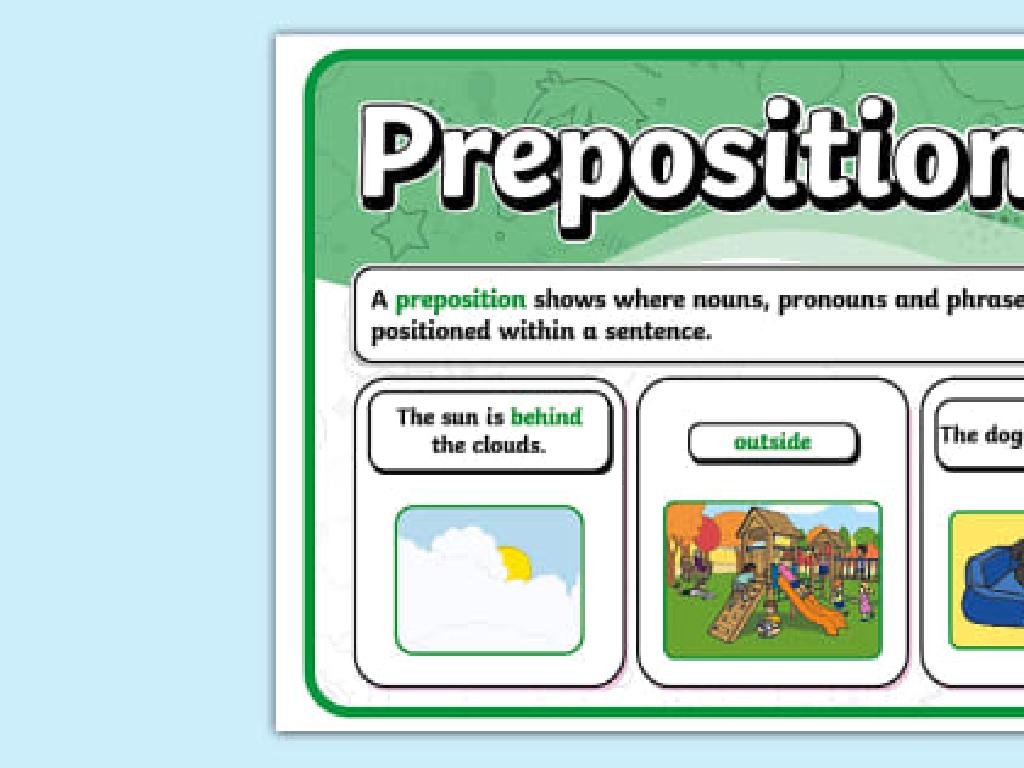Formatting And Capitalizing Titles: Review
Subject: Language arts
Grade: Sixth grade
Topic: Formatting
Please LOG IN to download the presentation. Access is available to registered users only.
View More Content
Welcome to Formatting Titles!
– Importance of title formatting
– Proper formatting makes titles clear and professional
– Defining titles and their significance
– Titles indicate the name of a work and grab attention
– Capitalizing titles correctly
– Use capital letters for the first and last words, and all important words in between
– Today’s lesson overview
|
This slide introduces the concept of formatting titles, emphasizing its importance in written communication. Explain that a well-formatted title can make a significant difference in how a piece of work is perceived. Discuss what titles are, highlighting their role in summarizing content and capturing the reader’s interest. The lesson will focus on the rules of capitalizing titles, ensuring students understand which words should be capitalized. Provide examples of titles from books, articles, and movies to illustrate proper capitalization. The overview of today’s lesson will set the stage for more in-depth learning and practice on title capitalization.
Understanding Titles in Formatting
– Define what a title is
– A title is the name of a work like a book or movie
– Titles: Books, Articles, Movies
– Examples: ‘Harry Potter’, ‘The New York Times’, ‘Frozen’
– Titles signify content importance
– Emphasizes what’s important in the text
– Titles guide readers’ expectations
– Helps readers predict what the text is about
|
This slide introduces the concept of titles and their significance in written works. Begin by defining a title as the name given to a piece of work to identify and represent it. Provide examples of titles from various sources such as books, articles, and movies to illustrate the point. Discuss how titles play a crucial role in highlighting the main idea or theme of the content and how they set the stage for the reader’s expectations. Encourage students to think of their favorite book or movie titles and consider what those titles tell them about the content. This will help them understand the importance of choosing an appropriate title for their own writing.
Capitalizing Titles in Formatting
– Capitalize first & last words
– Capitalize nouns, pronouns, adjectives
– Words like ‘he’, ‘she’, ‘big’, ‘small’ should be capitalized in titles
– Don’t capitalize short prepositions
– Words like ‘and’, ‘or’, ‘in’, ‘of’ usually stay lowercase
– Learn exceptions to rules
– Words that are not capitalized in titles can be tricky, like ‘is’
|
This slide reviews the basic rules of capitalization for titles in Language Arts for sixth graders. Emphasize the importance of always capitalizing the first and last words of titles, regardless of their parts of speech. Highlight that nouns, pronouns, verbs, adverbs, and adjectives are typically capitalized. Teach students that short prepositions, articles, and conjunctions are generally not capitalized unless they are the first or last words. Discuss exceptions, such as the verb ‘is’, which is always capitalized in titles, despite being a short word. Provide examples of titles that apply these rules and encourage students to practice by writing their own titles or correcting given ones.
Formatting and Capitalizing Titles
– Formatting various titles
– Learn to format book, article, and movie titles correctly.
– Italics vs. quotation marks
– Use italics for books/movies; quotes for articles/poems.
– Title formatting in sentences
– Incorporate correct title formatting within writing.
– Capitalization rules
|
This slide aims to review the rules for formatting and capitalizing titles in written work. Students should understand the difference in formatting titles of longer works like books and movies, which are typically italicized, versus shorter works like articles and poems, which are enclosed in quotation marks. Additionally, they should practice including correctly formatted titles within the context of sentences, adhering to capitalization rules such as capitalizing the first and last words of the title, as well as all major words in between. Provide examples for each case and encourage students to bring examples of titles they have come across in their reading.
Title Formatting Practice
– Identify correctly formatted titles
– Correct titles as a group
– Discuss importance of formatting
– Proper formatting helps convey respect for the work and aids in readability.
– Practice with examples
– Use book and movie titles to practice capitalization and punctuation.
|
This slide is aimed at reinforcing the rules for formatting and capitalizing titles through practice examples. Start by showing students examples of titles and asking them to identify which are correctly formatted. Then, work together as a class to correct a list of improperly formatted titles, discussing the changes as you go. Emphasize the importance of correct formatting, explaining that it shows respect for the work and helps readers understand what is significant. Finally, provide students with a variety of book and movie titles to practice applying the rules of capitalization and punctuation. This interactive approach will help students better grasp the concept and remember the rules.
Let’s Play a Game: ‘Capitalize This!’
– Learn game instructions
– Team up to capitalize titles
– Review and explain your answers
– Discuss why you chose to capitalize certain words
– Understand title capitalization rules
– Titles have important words capitalized, like nouns, verbs, and adjectives
|
This interactive game is designed to help students practice and reinforce their understanding of title capitalization rules. Divide the class into teams and provide each team with a list of book, movie, or article titles written in lowercase. The teams will work together to correctly capitalize the titles. Afterward, review the answers as a class, allowing teams to explain their reasoning for capitalizing certain words. This will help clarify any misconceptions and ensure that students understand which words to capitalize in titles, such as nouns, pronouns, verbs, adverbs, adjectives, and any word that is more than three letters long.
Class Activity: Crafting Creative Titles
– Write titles for your imaginary works
– Apply rules of capitalization and formatting
– Remember to capitalize the first and last words, and all important words in between.
– Share your titles with classmates
– Engage in a class discussion on your titles
– Discuss why you chose the title and the capitalization.
|
This activity is designed to reinforce the rules of capitalizing and formatting titles through a creative exercise. Students will imagine they are authors or creators and come up with their own titles for books, movies, or other works. They must apply the capitalization rules they’ve learned, such as capitalizing the first and last words of the title, as well as all principal words in between. After writing their titles, students will share them with the class and participate in a discussion, explaining their choices and reflecting on the importance of proper title formatting. Possible activities include creating titles for a fantasy novel, a superhero movie, a biography of a historical figure, or a new video game.
Conclusion: Title Formatting & Homework
– Recap title formatting rules
– Remember to capitalize first, last, and important words in titles.
– Consistency in formatting titles
– Consistent formatting helps readability and shows attention to detail.
– Homework: Title Hunt in Articles
– Find magazine/newspaper titles and correct their formatting.
– Share findings next class
|
As we conclude, remind students of the key rules for formatting titles, such as capitalizing the first and last words, as well as all major words in between. Emphasize the importance of consistency in formatting to maintain a professional and polished look in their writing. For homework, students should find titles in a magazine or newspaper article and correct them based on what they’ve learned. This practical exercise will reinforce their understanding of the rules. In the next class, students will have the opportunity to share their findings and discuss any challenges they encountered. This will also serve as a review and ensure that the students can apply the rules to real-world examples.






